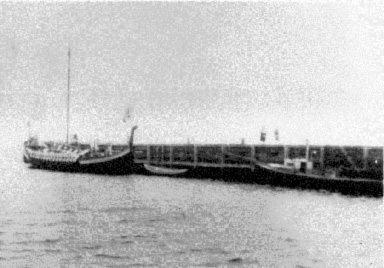
English Harbour Heritage Society
Contact Us
BillOshea
Website Design and Content © by Eric Krause,
Krause House Info-Research Solutions (© 1996)
All Images © Parks Canada Except
Where Noted Otherwise; Research
© Bill O'Shea
Researching the
Fortress of Louisbourg
National Historic Site of Canada
Recherche sur la Forteresse-de-Louisbourg
Lieu historique national du Canada
Search All Sites/All Menus ~
Cherche Tous les Sites/Tous les Menus
THE BILL O'SHEA WEBSITE
LOUISBOURG HISTORICAL NOT-FOR-PROFIT SOCIETIES

English Harbour Heritage Society
Contact
Us
Viking Ship Index:
| Viking Ship in Louisbourg | Another Viking Ship |

It was not until the Louisbourg Heritage Society received a letter from Else Marie Thorstvedt, the Librarian, of the Norsk Sjøfartsmuseum, in Oslo, that the rest of the story was discovered.
Ms. Thorstvedt wrote
" . . . Gerhard Følger also made a voyage across the Atlantic in 1926 with the LEIF ERIKSON. On that trip they left St. Johns, Newfoundland on Juy 15th after having stayed there 3 days. The LEIF ERIKSON was left in Duluth, in a park with the same name.
The following book has been published about the voyage: Gerhard Følger : Over Nordatlanteren i åpen boat. Oslo 1944. 128 pages, illustrated.
In May 1929 another replica of a vikingship was launched at the same boat yard at Korgen, Nordland ( North Norway) as where the LEIF ERIKSON was built.
The new ship ROALD AMUNDSEN departed from Korgen on May 10, 1929 and arrived Minneapolis/St. Paul, USA on September 22, 1930. On August 5, 1932 the ship left St. Johns, Newfoundland for Greenland, but had to change it's course because of icebergs and arrived Iceland instead on August 23, 1932. On September 2, 1932 the ROALD AMUNDSEN finally arrived Bergen. We are enclosing a copy of an article in a newspaper with extracts from a diary written by one of the crewmembers of that trip. The ROALD AMUNDSEN was used during the World War II taking refugees from Norway to Iceland. The Germans got knowledge of this and the ship was fired on and destroyed. Gerhard Følger was very heavily tortured and suffered from this the rest of his life.
In 1944 he published: Gerhard Følger : På vikinferd med 'Roald Amundsen'."
SOURCES
Halifax Herald, Halifax, Nova Scotia. 16 July 1932, p. 20; 18 July 1932, p. 12. Melvin
S. Huntington, Diary. 22 July 1932, 23 July 1932, 24 July 1932.
Professor Gwyn Jones, The Norse Atlantic Saga, Oxford University Press, 1986 (second
edition) mentions, in a footnote, "Captain Folgar, who in 1932 took a replica of a
60-foot knorr across the Atlantic by one of Columbus' routes and returned to Norway by way
of Newfoundland. . ." ( page 7, footnote #4)
This ship was not in Louisbourg. It was in the Columbian Exposition in Chicago in 1891. This section is taken from the Official Guide book.
" Viking Ship - Referred to briefly in connection with ethnological exhibit. An exact reproduction made by order of the Norwegian government of a vessel 1,000 years old. This craft is similar in all particulars to those used by the Norsemen in their raids upon Great Britain and Ireland, and is supposed to be a fac-simile of the ship Leif Erikson commanded when he landed upon the coast of Vinland. The original Viking ship from which the reproduction is made was discovered in a burial mound at Gokstad in 1889. To Captain Magnus Andersen belongs the honor of having first broached the suggestion of building an exact copy of the vessel with the idea of sending it to the Columbian Exposition. This idea was favorably received in Norway, and a national subscription to defray the expense of the undertaking was immediately begun. Eleven of the oldest and most experienced sea captains inspected the model, and were of the unanimous opinion that the voyage of the reproduced "Viking" could be made in safety. The work of building the ship began at once; she was launched at Sandefjord in the spring of 1893, the event being one of great festivity and pomp. The brow is adorned by a colossal and superbly carved dragon's head, and the stern with a dragon's tail; both ornaments are finished in burnished gold. Around the outside of the bulwark are rows of embellished shields of great beauty, and almost amidships rises a roofing painted in red and white stripes. This served the great vikings against the wind and wave. Astern stands a massive "highseat" for the chief or jarl. This chair, or rather throne, is covered with carved runic inscriptions in old Norse style. The vessel is open with the exception of a small deck fore and aft. There are two water tight compartments where the men on watch may take refuge during rough weather. The rigging is very simple, one mast, which can be taken down, and one yard. But the vessel is not altogether dependent on its sails. During a calm the vikings seize their mighty oars. On each side below the shields are sixteen holes for oars, and along the inside are benches for the rowers. The rudder is, after the custom of the old sea kings, carried on the right side of the vessel. The builder, Mr. Christiansen, took great pains in making this a masterpiece of the shipbuilder's art. The vessel is 76 feet in length. Exhibited in the South Pond, or on the lake shore near Anthropological building. Capt. Anderson is in command."
SOURCE
Official Guide to the World's Columbian Exposition, in the City of Chicago, State of Illinois, May 1 to October 26, 1891. Compiled by John J. Flinn. Issued Under Authority of the World's Columbian Exposition, [Souvenir Edition.] Chicago, The Columbian Guide Company, 358 Dearborn Street. 1893. pages 251 - 252